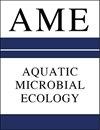Quorum sensing signal disrupts viral infection dynamics in the coccolithophore Emiliania huxleyi
IF 1.1
4区 环境科学与生态学
Q3 ECOLOGY
引用次数: 1
Abstract
Viruses that infect phytoplankton are abundant in all regions of the global ocean. Despite their ubiquity, little is understood regarding how biotic interactions can alter virus infection success as well as the fate of phytoplankton hosts. In previous work, the bacterially derived compound 2-heptyl-4-quinolone (HHQ) has been shown to protect the cosmopolitan coccolithophore Emiliania huxleyi from virus-induced mortality. The present study explores the potential mechanisms through which protection is conferred. Using a suite of transmission electron microscopy and physiological diagnostic staining techniques, we show that when E. huxleyi is exposed to HHQ, viruses can gain entry into cells but viral replication and release is inhibited. These findings are supported by a smaller burst size, as well as lower infectious and total virus production when the host is treated with nanomolar concentrations of HHQ. Additionally, diagnostic staining results indicate that programmed cell death markers commonly associated with viral infection are not activated when infected E. huxleyi are exposed to HHQ. Together, these results suggest that the ability of HHQ to inhibit infectious viral production protects the alga not from getting infected, but from cell lysis. This work identifies a new mechanistic role of bacterial quorum sensing molecules in mediating viral infections in marine microbial systems.群体感应信号破坏huxleyi球石藻的病毒感染动力学
感染浮游植物的病毒在全球海洋的所有区域都很丰富。尽管它们无处不在,但对于生物相互作用如何改变病毒感染的成功以及浮游植物宿主的命运,人们知之甚少。在以前的工作中,细菌衍生的化合物2-庚基-4-喹诺酮(HHQ)已被证明可以保护世界性的球石藻埃米利亚·赫胥黎免受病毒引起的死亡。本研究探讨了保护作用的潜在机制。利用一套透射电子显微镜和生理诊断染色技术,我们发现当赫胥黎氏杆菌暴露于HHQ时,病毒可以进入细胞,但病毒的复制和释放受到抑制。当用纳摩尔浓度的HHQ处理宿主时,更小的爆发大小以及更低的传染性和总病毒产量支持了这些发现。此外,诊断染色结果表明,通常与病毒感染相关的程序性细胞死亡标志物在感染的赫胥黎肠杆菌暴露于HHQ时不被激活。总之,这些结果表明,HHQ抑制感染性病毒产生的能力不是保护藻类免受感染,而是保护藻类免受细胞裂解。这项工作确定了细菌群体感应分子在海洋微生物系统中介导病毒感染的新机制作用。
本文章由计算机程序翻译,如有差异,请以英文原文为准。
求助全文
约1分钟内获得全文
求助全文
来源期刊

Aquatic Microbial Ecology
环境科学-海洋与淡水生物学
CiteScore
3.30
自引率
0.00%
发文量
8
审稿时长
3.0 months
期刊介绍:
AME is international and interdisciplinary. It presents rigorously refereed and carefully selected Research Articles, Reviews and Notes, as well as Comments/Reply Comments (for details see AME 27:209), Opinion Pieces (previously called ''As I See It'') and AME Specials. For details consult the Guidelines for Authors. Papers may be concerned with:
Tolerances and responses of microorganisms to variations in abiotic and biotic components of their environment; microbial life under extreme environmental conditions (climate, temperature, pressure, osmolarity, redox, etc.).
Role of aquatic microorganisms in the production, transformation and decomposition of organic matter; flow patterns of energy and matter as these pass through microorganisms; population dynamics; trophic interrelationships; modelling, both theoretical and via computer simulation, of individual microorganisms and microbial populations; biodiversity.
Absorption and transformation of inorganic material; synthesis and transformation of organic material (autotrophic and heterotrophic); non-genetic and genetic adaptation; behaviour; molecular microbial ecology; symbioses.
 求助内容:
求助内容: 应助结果提醒方式:
应助结果提醒方式:


